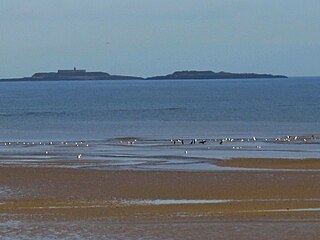
HMS Gorgon was a 44-gun fifth-rate two-decker ship of the Adventure class of 911 tons, launched at Blackwall Yard in 1785 and completed as a troopship. She was subsequently converted to a storeship. She also served as a guardship and a hospital ship at various times before being broken up in 1817.

HMS Hannibal was a 74-gun third-rate ship of the line of the Royal Navy, launched on 15 April 1786, named after the Carthaginian general Hannibal. She is best known for having taken part in the Algeciras Campaign, and for having run aground during the First Battle of Algeciras on 5 July 1801, which resulted in her capture. She then served in the French Navy until she was broken up in 1824.

Îles Saint-Marcouf comprise two small uninhabited islands off the coast of Normandy, France. They lie in the Baie de la Seine region of the English Channel and are 6.5 km (4.0 mi) east of the coast of the Cotentin peninsula at Ravenoville and 13 km (8 mi) from the island of Tatihou and the harbour at Saint-Vaast-la-Hougue. In addition to the fortifications described below, on the larger island there is a lighthouse that dates to 1948.
HMS Lively was a 32-gun fifth-rate Alcmene-class frigate of the British Royal Navy launched on 23 October 1794 at Northam. She took part in three actions – one a single-ship action, one a major battle, and one a cutting-out boat expedition – that would in 1847 qualify her crews for the issuance of the Naval General Service Medal. Lively was wrecked in 1798.
Vénus was a corvette of the French Navy that the British captured in 1800. Renamed HMS Scout, she served briefly in the Channel before being wrecked in 1801, a few days after taking a major prize.

The Battle of the Îles Saint-Marcouf was an engagement fought off the Îles Saint-Marcouf near the Cotentin peninsula on the Normandy coast of France in May 1798 during the French Revolutionary Wars. Dislodging a British garrison on the islands was the main objective for French forces. The garrison allowed the islands to serve as a resupply base for Royal Navy ships patrolling northern French waters. Apart from expelling the British, the French sought to test new equipment and tactics, which had allegedly been developed with an intention of invading Britain.
HMS Sandfly was a Musquito-class floating battery of the Royal Navy. The two-vessel class was intended to defend the Îles Saint-Marcouf (Marcou) situated off the Normandy coast. During her brief career Sandfly shared in the capture of one privateer and participated in a battle that would earn her crew the Naval General Service Medal. The Peace of Amiens returned the islets to France in May 1802; Sandfly was paid off in June 1802 and broken up in 1803.
HMS Shark was a former Dutch hoy that the British Admiralty purchased in 1794 for service with the Royal Navy. In 1795 her crew mutinied and handed her over to the French.
The Musquito class was a Royal Navy class of two 4-gun floating batteries built to a design by Admiral Sir Sidney Smith specifically to serve with his squadron in French coastal waters. Both were named and ordered under Admiralty Order 26 May 1794.
HMS Serpent was a former Dutch hoy that the British Admiralty purchased in 1794 for service with the Royal Navy. She was paid off in 1796 and was sold around 1802.
HMS Badger was a Dutch hoy, one of some 19 that the Admiralty purchased for the Royal Navy in 1794 after France's declaration of war in 1793. The intent was to create quickly a class of gun-vessels for operations in coastal and shallow waters. Of all the hoys, she had probably the most distinguished career in that she helped fend off two French attacks on the Îles Saint-Marcouf, and participated in the capture of several French vessels. The Navy sold her in 1802.
Poulette was a French Coquette-class corvette built to a design by Joseph-Marie-Blaise Coulomb and launched in March 1781. She served the French navy until 1793 when the British captured her at Toulon in 1793. She served briefly in the Royal Navy, including at the battle of Genoa in 1795, until she was burned in October 1796 to prevent her falling into French hands.
HMS Ranger was the 14-gun revenue cutter Rose, launched in 1776, that the Royal Navy purchased in 1787, and that the French captured in 1794. The British recaptured her (twice) in 1797 and renamed her HMS Venturer. The Navy sold her in 1803.
HMS Nancy was the mercantile vessel Nancy that the Royal Navy purchased in 1794 for use as a fire ship. She was never expended as a fireship but instead served as a small gunboat. The Navy sold her at Deptford in 1801.
At least two vessels named Swallow served the British Royal Navy as a ship's tender. These vessels were never commissioned and so technically do not qualify for the prefix "HMS".
Between 1793 and 1805, five cutters served the British Royal Navy as hired armed vessels under the designation HM hired cutter Rose:
HMS Attack was launched in 1794 as a Conquest-class gunvessel for the Royal Navy. She had an uneventful career and the Navy sold her in 1802.
HMS Wolf was a 4-gun gunvessel, originally a Dutch hoy that the British Admiralty purchased in 1794 for service with the Royal Navy. She was broken up in 1803.
HMS Tickler was launched in 1794 as a Conquest-class gunbrig. She was sold in 1802.



